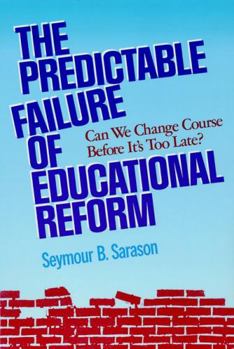The Predictable Failure of Educational Reform: Can We Change Course Before It's Too Late?
Select Format
Select Condition 
Book Overview
Sarason challenges educators to understand that to continue tostruggle for 'power over' rather than 'power with' overlooks themutual interest of all parties that will stifle any real progressin education reform. In a classroom utilizing effective teachingpractices students would respond to the question, 'How do you ratethis book?' with all thumbs up. ?Choice
Format:Paperback
Language:English
ISBN:1555426239
ISBN13:9781555426231
Release Date:December 1993
Publisher:Jossey-Bass
Length:208 Pages
Weight:0.13 lbs.
Dimensions:0.6" x 6.0" x 9.0"
Customer Reviews
2 ratings
The Failure of Educational Reform
Published by Thriftbooks.com User , 22 years ago
Seymour Sarason's thoughts on educational reform are shown in both a positive and negative light. He believes that change in educational practices must be radical if they are going to work. He states, "To us, the biggest risk in education is not taking one." He maintains that it is certain disaster to continue fine tuning an already broken system. As an educator, I find that Sarason establishes grounds for his concerns even though his critism is gloomy at best. He continues to go back to the bottom line and question whether schools are really doing what is best for children. On a positive note, Sarason raises valid points that challenge educators to look at their own practices and beliefs in a way that will make learning and student achievement foremost in every classroom. It would be difficult to read his book and not feel the need for change. How radical the change needs to be is uncertain, unless one agrees with Sarason.
Why Education Reform Has Failed
Published by Thriftbooks.com User , 23 years ago
Sarason writes for those who are members of the community of learners and members of the political community whose role and power affect the direction of educational reform. His ideas are not unique, but are distinctive in that there is an emphasis of ideas that have in the past have been kept separate. His belief is that as long as we keep them separate, failure will occur. Chapter One discusses the inability of past reform efforts to be effective in making changes occur, and why this dilemma condemn to failure current and future attempts. Chapter Two will review the obstacles when those initiating reform encounter when they don't truly understand the dynamics of the educational system. Chapter Three takes an in depth look at the power relationships within the system, and failure to do so will prevent desired changes from occurring. Chapter Four asks the difficult question as to whom should be involved in the decision-making. The educational system and private sector are compared. The Scanlon Plan is also discussed. Chapter Five will delve into the power structure within the educational system as related to the power relationships within the classroom. There are five examples provided in Chapter Six as to why efforts in educational reform have not been successful. Sarason will compare the educational systems with the medical profession, and the relationship to changes in both areas. Implementation, imitation, and replications of reform efforts are rarely successful. This failure will be discussed in Chapter Seven. Chapter Eight seeks to give you further food for thought in answering that age old question, "For whom do schools exist?". The author will take the position that schools equally exist for the development of both staff and students. Chapter Nine attempts to answer a multitude of questions which focus on the overarching goals for students.The text is written in a manner that is easy to understand, and provides a multitude of topics which would be a starting point for professional discussions. The course I am involved in at UNO (Omaha) challenges doctoral students in educational administration to step out of the box, challenge to question tradition, and ask difficult questions. This book provides for the foundation for those discussions and a point of reference from which to start when we ask ourselves why have reform efforts failed to achieve the goals we have established. (This review has been written in the format established by the author in the preface.)






